Despite water making up 71% of Earth’s surface and being as vital as air for humans to sustain their existence, we can’t drink just any water. There are many kinds of water based on access points, collection sources, treatment methods, and ingredient content. It is therefore crucial to know more about the different water types to make informed choices regarding the water you use and consume.
What is the Healthiest Water to Drink?
Spring water is the best water to drink in 2024 because it contains healthy minerals like sodium, calcium, magnesium and potassium. It is 100% pure and free of common drinking water contaminants like lead and chlorine.
Here are the benefits of drinking spring water:
- It is pre-purified thanks to geographical formations that have natural filtering capabilities. Therefore, unlike the majority of other water types, it needs no further treatment prior to bottling and consumption.
- Thanks to these natural filters, it contains no hazardous contaminants (unlike tap water or well water)
- Its rich mineral content makes it one of the healthiest water types alongside alkaline water and mineral water, and that’s why it’s preferable to treated water like distilled, RO, or purified water
- Its electrolyte content makes it the ideal drinking water choice for athletes
- Since its mineral and TDS content isn’t over 250 ppm, it doesn’t taste as bitter as mineral water or sparkling water
- It doesn’t have any additives, i.e., it’s served directly from a spring
- Since it needs no treatment or additives like alkaline water or sparkling water, and since it doesn’t have any ingredient thresholds like mineral water, it’s one of the most affordable types of bottled water
In the sections below, we share in-depth information, analyze the different types of water to tell you which type contains what, and explain the benefits and drawbacks of each.
The Main Types of Water Based on Source (Accessibility)
How and where you access drinking water can tell you a lot about what it contains and how it is or should be treated.
Here are the most common water sources:
- Tap water: Tap water is water that’s supplied to the faucets at your household by municipal water supply systems regulated by the Environmental Protection Agency (EPA). Depending on the water source, the municipal authorities and water suppliers may subject it to different treatment techniques. As such, this water differs in quality depending on the water source and location. This is why we have discrepancies in the water quality of most US states & cities.
- Well water: Well water, also known as groundwater, comes directly from underground aquifers. The geographical formations (the types of stones and rocks) through which it flows play a significant role in what it contains. More often than not, it requires home water treatment or softening devices before consumption.
- Bottled water: Bottled water has many sub-categories like distilled water, purified water, alkaline water, mineral water, and spring water, and all of them have different sources and undergo different treatment techniques
1. Tap Water
Most urban residences in the United States are connected to municipal water supply systems for which residents pay a certain sum on a monthly basis. These systems might draw water from different sources like surface water (rivers, lakes, and sometimes even the ocean) and groundwater (water that accumulates in underground aquifers over millennia).
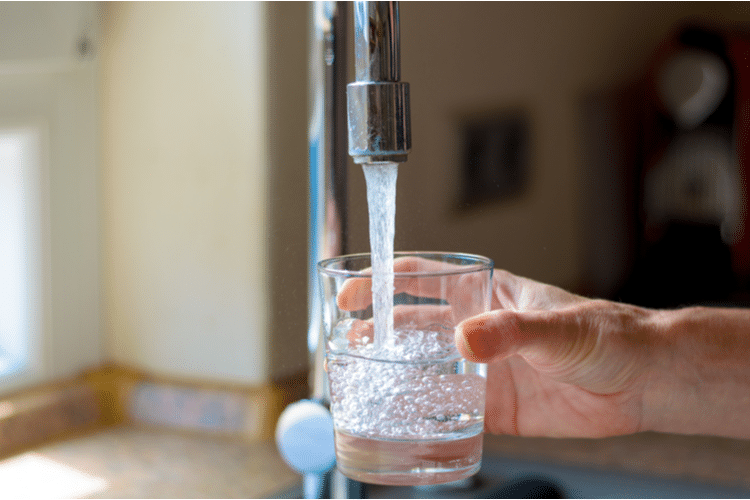
The water quality of such water systems is tested by the suppliers in accordance with the regulations and standards set by the EPA under the National Primary Drinking Water Regulations (NPDWRs, pertaining to health hazards) and National Secondary Drinking Water Regulations (NSPDWRs, pertaining to aesthetic impurities like color, taste, and odor).
However, the fact tap water is regulated and held up to certain standards doesn’t necessarily standardize its quality, content, or how it’s collected.
For instance, tap water drawn from an underground water source that sits on top of mineral-rich rocks will have a higher mineral content than its alternatives. Similarly, tap water drawn from surface water sources prone to contamination by human and animal waste (because the source is out in the open) will have a more diverse body of contaminants.
Still, water suppliers and municipal authorities treat tap water regardless of the source, to provide healthy water to residents.
Typical tap water treatment methods feature:
- Coagulation, flocculation, and sedimentation: A coagulant is introduced to the water stored in a big tank. When contaminants start reacting with this coagulant, they form larger particles called flocs. At the end of the flocculation process, these large particles sink to the bottom of the tank, which is called sedimentation.
- Filtration: Not all minute contaminants can floc, so they need further treatment. To this end, the water is transferred to another tank. During this transfer, it passes through multiple filters that vary in technology depending on what the water supplier aims to remove. These technologies might include activated carbon, reverse osmosis, distillation, deionization, or all.
- Disinfection: To prevent pathogenic micro-organisms like bacteria, viruses, and microbes from contaminating water, water suppliers pump disinfecting chemicals like chlorine, chloramines, or ozone into the water system. The levels of these chemicals never exceed EPA standards. Some municipalities also add fluoride to their public water systems to promote teeth health. Like disinfecting chemicals, fluoride levels in public water don’t exceed health standards set by the EPA.
Of course, claiming that every city and state meets EPA regulations at all times and that tap water quality is reliable everywhere would be a mistake. That’s why many Americans opt for home water filtration systems or at least water pitchers, like Brita, for safe drinking water.
That being said, there are also cases worldwide, like in Luxembourg, where water is directly drawn from springs and sent to the taps of citizens without any treatment process. Of course, such water supplies require the existence of uncontaminated springs that can provide water for a whole city and rigorous protection laws that keep the springs safe from sources of contamination, such as agricultural and industrial waste.
2. Well Water
Well water is water that’s directly drawn from an aquifer with the help of a well pump and casing. Private wells are quite common in rural America because rural communities rarely have access to a municipal water supply, and there’s no authority that regulates these wells.
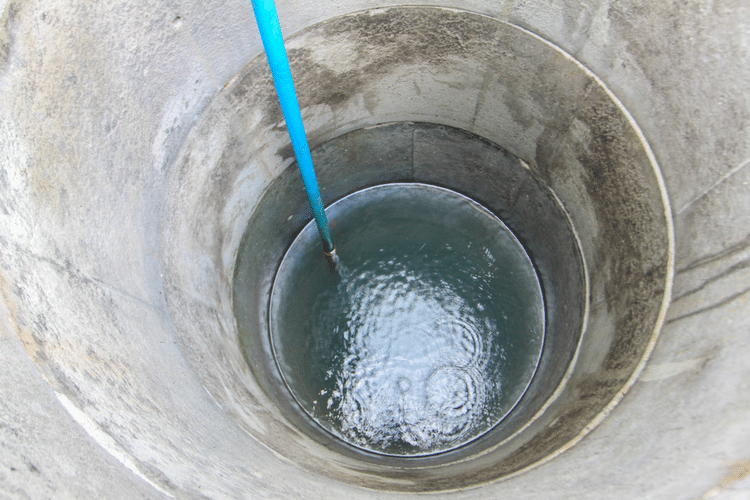
Even though some rural communities have access to municipal supplies, citizens might still want to dig their own wells because they either have low trust in water suppliers or the municipal water is not reliable, like in the case of the Flint water crisis.
Depending on the location, well water will have different characteristics. Proximity to agricultural sites, whether the water source is well-protected from surface water run-off that might carry industrial waste to the underground water reservoirs, and the distance between a septic tank and the well casing all might play a role in the contamination risk of private wells.
Therefore, even though wells nowadays come with sediment filters, most private well owners opt for home water treatment solutions. Whole-house filtration systems or reverse osmosis units are almost a must for filtering well water to prevent any possible contamination.
Furthermore, while wells that sit upon mineral-rich grounds are abundant with healthy minerals, that isn’t necessarily a good thing for people who depend on well water for basic household chores like laundry and dishwashing. As water that’s rich with minerals like calcium and magnesium is essentially hard water, it leads to:
- limescale formation on surfaces, kitchenware, and clothes
- decreased life expectancy of appliances due to mineral buildup, and
- pipes becoming clogged
So, in addition to home water treatment systems, many private well owners install water softeners to alleviate the adverse effects of hard water.
These are not the only disadvantages of well water. Since wells are not subject to EPA regulations, the burden of maintaining them in accordance with health standards (for example, checking them for bacterial contamination) falls on the owner’s shoulders. To that end, the Centers for Disease Control and Prevention recommend that owners should have their well checked and tested by professionals at least once a year.
3. Bottled Water
You can get bottled water in almost every shop all across the world. Although the use of plastics in bottling makes it less eco-friendly than the alternatives above, and despite the fact that it’s the most expensive water you can drink, it’s also the safest and healthiest.
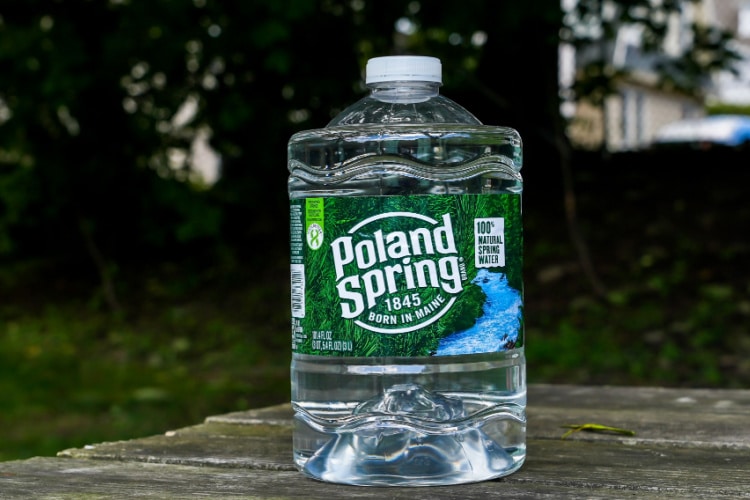
The reason behind its safety is that bottled water isn’t only regulated by the EPA (under both NPDWRs and NSDWRs) but also by the United States Food and Drugs Administration (FDA) simply because it’s a packaged dietary product.
So, even though some bottled water might be in plastic bottles, the FDA ensures that these bottles don’t leach any problematic micro-plastics like BPAs into the water.
However, we should note that the long-term health effects of micro-plastics are still understudied, so it’s best to stick to glass bottles when purchasing bottled water.
The FDA regulates bottled water on three main standards:
- Standard of identity: This standard pertains to what type of water is inside the bottle. We’re going to detail these types later in this section
- Standard of quality: Quality means what kind of contaminants, be it chemical, microbial, physical, or even radiological, are inside the water and whether their levels are in compliance with EPA standards. Additionally, it relates to mineral levels.
- Current good manufacturing practice: This regulation establishes whether the material used for making the bottle and its lid are safe for food and beverage packaging. It also ensures that the production of a certain item has taken place under sanitary conditions.
Different Types of Bottled Water
In addition to the standards we just mentioned above, the FDA classifies different types of bottled water as follows:
- Artesian well water: This water type is defined on the basis of how bottled water manufacturers collect water from underground sources. Artesian well water is collected by applying artesian pressure (tapping into an underground aquifer and forcing its water to the surface) through a well.
- Distilled water: Distilled water is water that’s been treated with the distillation method. Distillation entails boiling water until it’s all vapor and then cooling the vapor down to return it to its liquid state, but now, free of contaminants.
- Deionized water: In the deionization process, the water is passed through an ion exchange resin. This resin removes ionic elements, mostly minerals, from water.
- Reverse osmosis water: Reverse osmosis (RO) is a filtration process in which water passes through a 0.0001-micron semipermeable membrane. Due to its minute pore size, this membrane can efficiently remove many contaminants.
- Purified water: Purified water is defined on the basis of how the water is treated. If the treatment procedure eliminates all impurities and minerals, then, regardless of the source, the water is considered ‘purified.’
- Mineral water: Mineral water should be directly collected from an underground aquifer (through a spring or an underground borehole) and contain at least 250 ppm (parts per million) of total dissolved solids. Manufacturers can’t add any minerals or solids to the water after collection, and they also can’t treat it.
- Spring water: Like mineral water, spring water should be directly collected from its aquifer, and it shouldn’t be subjected to any treatment whatsoever before bottling
- Sparkling water: More often than not, mineral water and spring water are alkaline in essence due to their high mineral content. Some brands add carbon dioxide to such mineral-rich water to render them more acidic. When mineral or spring water is treated with carbon dioxide, we get sparkling water.
We’ll provide more detailed information on the different water types in the following sections.
Best Water to Drink Based on Water Treatment Methods
Except for mineral and spring water, all water types are treated one way or another.
Depending on the quality of the water source, municipal water authority, water supplier, or bottled water brand, these treatments might differ from carbon block filters that can only remove aesthetic impurities (odor, taste, and color) to reverse osmosis filtration that can effectively remove almost any impurity.
The best filtered water to drink is:
- Reverse osmosis water
- Distilled water
- Purified water
Note: One common downside to these water filtration processes is that they also filter healthy minerals. So, they may not be the “healthiest” for you if you’re interested in water with mineral content.
1. Reverse Osmosis Water
Nowadays, reverse osmosis technology is an essential component of many whole-house filtration units, industrial-scale drinking water treatment plants, car wash businesses, and bottled water manufacturing. This is because RO is one of the most effective ways of removing many hazardous drinking water contaminants that pose serious health threats, like lead, arsenic, and radium.
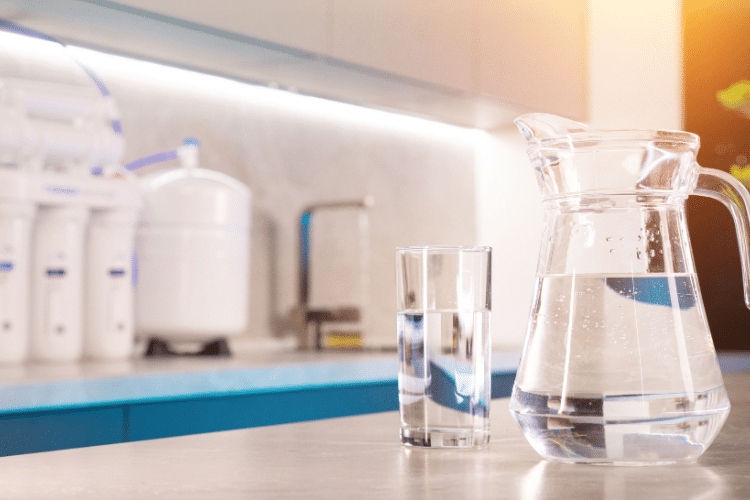
Its wide array of use is also due to the fact that the only thing the RO technology requires is a 0.0001-micron semi-permeable membrane, whereas cheaper and equally effective treatment methods, like distillation, require lots of heat, tanks, and tubes. So RO can treat water without causing any disruption to the water flow.
But, despite the fact that it’s part of many home water treatment units and it can effectively remove all kinds of hazardous contaminants, does RO provide the “healthiest” water to drink?
The answer to that question is no.
Similar to distillation, RO units also remove healthy minerals from water. Even though some household filtration systems boast that they throw state-of-the-art remineralizers into the mix, there’s no research that proves these remineralizers work. So, if you don’t want to lose crucial minerals from your diet, you may want to look into how to remineralize RO water.
Additionally, RO decreases the pH level of water to acidic levels of 5 to 7. As acidic water can dissolve any heavy metals it comes into contact with, putting RO water into metal cups might increase the risk of lead, copper, and even arsenic sneaking back into your drinking water.
Lastly, similar to distilled water, RO water also has a bland taste to it. However, water treatment brands try to compensate for that by adding an activated coconut carbon shell to their filtration units, which gives water a slight taste of coconut.
Still, despite the pleasant taste of coconut, RO water can hardly be considered the healthiest water to drink when you take into account its no-mineral content and acidic nature.
2. Distilled Water
As we said before, distilled water is simply water that is treated through a distillation process. Although the distillation method is mostly used in industrial-scale water treatment, you can also purchase a countertop distiller and reap the benefits of this conventional water treatment technique at home.
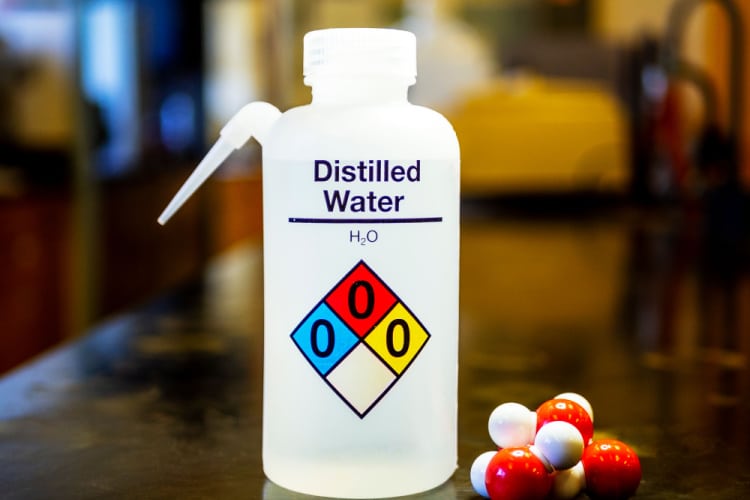
The distillation process leaves no or very little contaminant content in the water:
- Water is boiled in a large tank until it’s all vapor
- This vapor, consisting only of hydrogen and oxygen atoms, is then transferred to another tank via tubes
- Since contaminant molecules have nothing to stick to, they evaporate
- The vapor is then cooled down so that it can return to its liquid state
You might think that contaminant-free water is the healthiest kind of water you can drink, but it’s simply not the case. During the gas state, healthy minerals like calcium, magnesium, and potassium can’t find anything to cling to, so they’re removed from the water as well.
What you have in the end is just hydrogen and oxygen molecules. As such, the taste of distilled water is quite bland, and may not provide a pleasant drinking experience for many.
In short, the fact that it’s dKind Water Systemsid of healthy minerals and has a bland taste makes distilled water an uncommon choice for drinking.
However, it is use in:
- Medicine: CPAP machines that help people with sleep apnea and kidney dialysis machines that cleanse blood often utilize distilled water precisely because it’s neutral and bland
- Labs: If a chemist wants to run an experiment that somehow involves water, their main preference is often distilled water due to its neutrality
- Cosmetics: Distilled water is an essential ingredient in many perfumes, deodorants, shampoos, and skincare products
- Automotive: Water completely free of minerals has no abrasive effects on the paint, metal, or glass of automobiles
3. Purified Water
According to the FDA, it’s possible to purify any kind of water, be it surface water, groundwater, or simply tap water. The only thing that matters for water to qualify as purified is that it undergoes treatment, so there’s no impurity left.
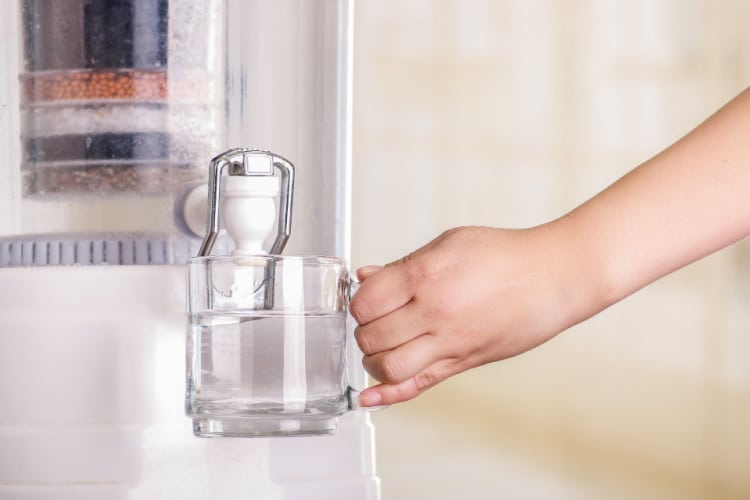
To achieve purified water, bottled water brands and municipal water suppliers might subject water to multiple treatment techniques. We have already covered some of these treatment techniques above:
- Coagulation: Adding a chemical coagulant to water held in a big tank
- Flocculation: Making little contaminant particles larger (flocs) through the chemical reactions produced by the coagulant
- Sedimentation: Sinking flocs to the bottom of the tank
- Filtration: Subjecting water to different and sometimes multiple filters
- Disinfection: Adding a disinfecting chemical like chlorine or ozone to water to prevent pathogenic microorganisms from infiltrating it
Depending on the water source and the preference of brands or municipal authorities, the filtration techniques for producing purified water might include the following:
- Absolute 1-micron filtration: If the water source isn’t particularly contaminated with extremely small contaminants, like volatile organic compounds, a 1-micron filter might filter out the impurities like sediment, clay, and dirt
- Distillation: As explained above, distillation means boiling water until it’s all vapor and then cooling it down to its liquid state, thus separating many molecular contaminants from the body of water
- Reverse osmosis: For contaminants with very small particles, RO is the most efficient method of removal due to the 0.0001-micron pore size of the semipermeable membrane employed in this treatment method
- Deionization: Deionization aims to remove elements that have an ionic structure. Even though it’s mostly employed to remove mineral salts, some deionizing resin can reduce lead levels in the water as well
There are also some home water treatment systems that can produce purified water to the standards set by the FDA and EPA. The Big Berkey countertop water filter is one of those systems.
That said, the same problem with distilled and RO water applies to purified water. Purified water has no or very little mineral content left after undergoing treatment, which means that it’s not the healthiest water to drink.
Best Water to Drink Based on Minerals/Ingredients
As we mentioned earlier when talking about distilled water, pure/neutral water consists only of hydrogen and oxygen atoms. So, what else can different types of water contain?
The only ingredients that matter when it comes to drinking water are healthy minerals and electrolytes that are and should be part of everyone’s diet. The most important minerals are calcium, magnesium, potassium, and bicarbonates.
Based on these ingredients, water can be classified into the following categories:
- Spring water: Water directly bottled from a spring or an underground borehole
- Mineral water: Water directly bottled from its source without any treatment that has at least 250 ppm of total dissolved solids (TDS)
- Alkaline water: Water with a pH level of more than eight, thanks to its bicarbonate content
- Sparkling water: Water that has acidic content due to its treatment with carbon dioxide.
1. Spring Water
Like mineral water, spring water should be directly bottled from its source, be it a spring or an underground borehole. However, unlike mineral water, there is no threshold for TDS content in spring water. This means that bottled water brands might label any water that has less than 250 ppm of TDS (which is the threshold for mineral water) as ‘spring water.’
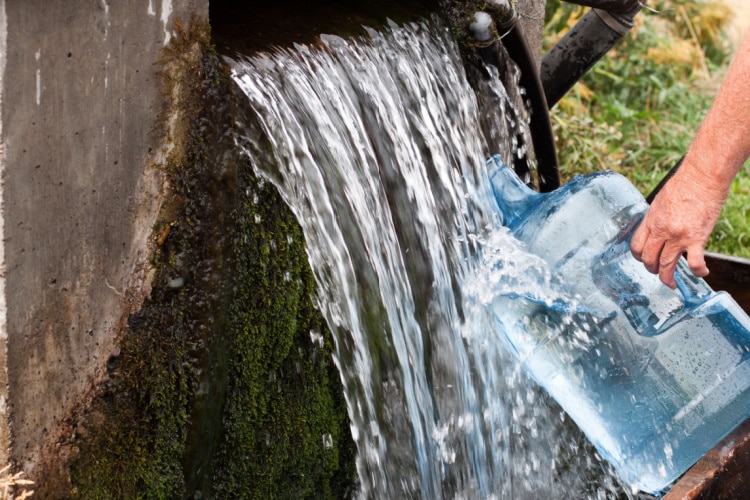
Spring water is often referred to as “pre-purified water” because, along its natural course through soil and underground waterways, it passes through geographical formations with natural filtering capacities, like limestone, sandstone, and clay. Not only do these formations help purify water from the hazardous elements (like heavy metals or chemicals) it might be carrying, but they also enrich it with their mineral content.
So, having less than 250 ppm of TDS doesn’t mean that spring water has no healthy minerals. Even though their levels ultimately depend on the geographical formation around the water source, most spring water on the market have all the healthy minerals such as sodium, calcium, magnesium, bicarbonates, and potassium.
Additionally, due to its bicarbonate content, all spring water is naturally alkaline without any human interference prior to bottling. So, it carries all the benefits of alkaline water as well.
You might have heard before that spring water is what athletes prefer to drink. That’s because spring water naturally contains electrolytes like phosphorus and chloride that help the flow of oxygen through the blood, muscle contractions, digestion, and nerve signaling.
Additionally, despite its rich mineral and electrolyte content, spring water doesn’t taste as bitter as mineral or sparkling water. That, combined with all the other great things about it we listed above, makes spring water the best water to drink.
Of course, not all spring water is under the control and initiative of bottled water brands. You can simply sign up on findaspring.com to find nearby springs that you may visit freely or by paying a certain fee, the ingredients of their water, and how you can reach them.
That said, not all natural springs have drinkable water because some sources are not well-protected – meaning they’re open to contamination by human, animal, industrial, and agricultural waste. This is why the New York State Department of Health warns citizens against drinking from untested and unregistered roadside springs.
2. Mineral Water
As can be derived from its name, mineral water has lots of dissolved minerals in it. According to the FDA, the total dissolved minerals and solids inside the water should be at least 250 ppm for bottled water brands to label their products as ‘mineral water.’
However, unlike with alkaline water, brands can’t add minerals prior to bottling. The water source should naturally contain all the dissolved solids, and the water should not be subjected to any kind of treatment or interference afterward.
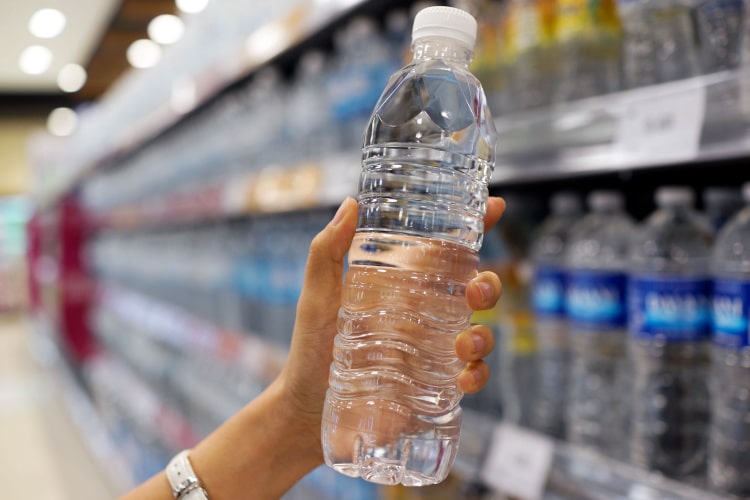
As such, the minerals found in a certain kind of bottled mineral water and their levels vary depending on the location of the water source. As water picks up these minerals and they get dissolved within its body when it’s making its way from the surface to the ground and the ground to the spring, the mineral content ultimately depends on the geological formations it passes over and through.
The most common minerals found in mineral water and their health benefits are the following:
- Sodium: Although sodium is an essential mineral for our bodies, its presence in water doesn’t bear much importance because sodium deficiency is almost non-existent. On the contrary, people with pre-existing heart conditions are mostly on low-or no-sodium diets. So, they should be wary of drinking sodium-rich mineral water.
- Calcium: In contrast with sodium, there’s an alarming decrease in calcium intake among Americans. Even though there are other dietary sources for calcium, like milk, human bodies absorb this mineral more efficiently from water. As calcium plays a significant role in muscle and bone health, it’s important to avoid mineral-free water and stick to water that’s rich in calcium.
- Magnesium: Our magnesium intake is no better than our calcium intake, and magnesium is as important for our bodies as calcium. It regulates blood pressure, maintains muscle contractions, and prevents bone loss. A 2017 study also shows that magnesium-rich water increases bowel functions and prevents constipation.
- Potassium: Potassium is another mineral that we typically consume below the recommended dosage. Since it helps with blood pressure, urination, kidney function, and bone growth, we should up our potassium intake in our daily diet by at least drinking potassium-rich water.
- Bicarbonates: Apart from functioning as a pH balancer, bicarbonates in water also reduce cholesterol and cardiovascular risk, especially in postmenopausal women.
The list above is a testament that mineral water is among the healthiest types of drinking water. But, why isn’t it the best water to drink? Well, water with such high mineral content inevitably tastes bitter, which is why we can’t recommend mineral water as the best type of drinking water for anyone. We recommend spring water instead!
3. Alkaline Water
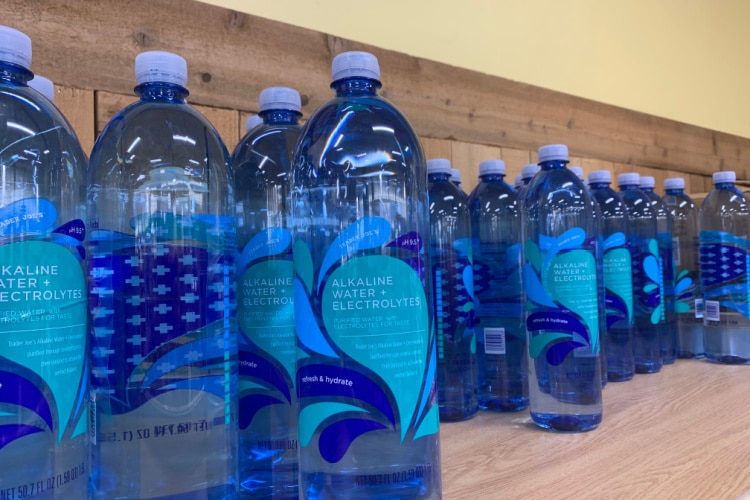
On a pH scale, the area between 7 and 8 means that the water in question is neither acidic nor alkaline. When the pH goes below 7, like in the case of RO water and sparkling water (which we will cover later), the water becomes acidic. When it goes above 8, it’s considered alkaline.
The alkalinity of water is mainly due to its calcium, magnesium, and bicarbonate content. But in some cases, the presence of only bicarbonates might change the pH level of the water regardless of calcium and magnesium.
This is why some bottled water brands carbonate their water after it’s collected, and that’s how alkaline water differs from other water types that usually have an alkaline nature (like some mineral water and most spring water).
Similar to the treated types of water we mention above, there are no hazardous contaminants in bottled alkaline water since it should comply with the standards set by the FDA and EPA. But, unlike other types, the alkaline nature of this type of water gives it certain benefits:
- The bicarbonates inside drinking water help us maintain the pH of our blood. Considering that the standard American diet is highly acidic and acidifying with lots of sugar, dairy, and meat, it’s important to balance this diet with alkaline water.
- A 2012 study shows that drinking alkaline water may help with acid reflux by neutralizing the main enzyme that creates it – pepsin
- A 2016 study found that drinking alkaline water improves blood flow, especially after a heavy workout routine
- A 1997 study proved that alkaline water may protect us from oxidative damage caused by air pollution and cigarette smoke by working as an antioxidant against free radicals
There are also a wide range of claims that alkaline water has anti-aging properties, helps with weight loss, supports the immune system, and cleanses the colon. Yet, these claims aren’t backed by comprehensive scientific research yet.
Despite all its merits, though, bottled alkaline water is one of the most expensive bottled water types on the market. So, unless you have the chance and means to build a private well on top of a naturally alkaline underground aquifer, it might not be a sustainable choice in the long run.
4. Sparkling (Carbonated) Water
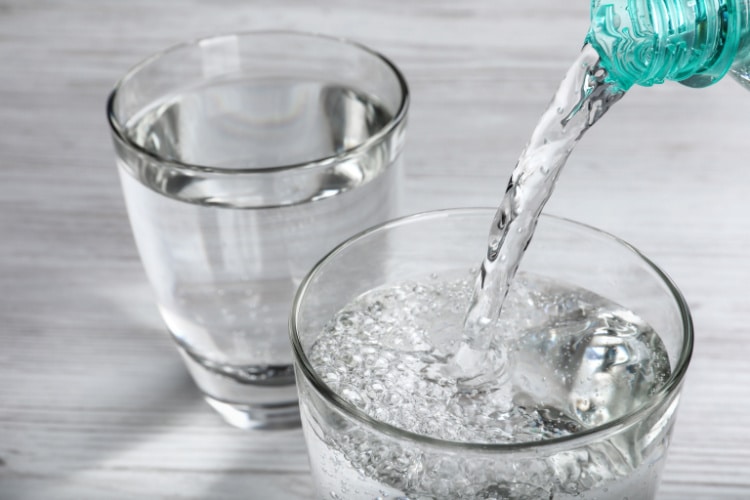
You’ve probably come across sparkling water in many forms, as it’s also known as seltzer, soda water, club soda, and fizzy water. All these types of water are produced through the process of carbonation.
Carbonation means adding carbon dioxide to the water under pressure after it is collected from an underground source or treated through the purification methods listed and explained above. When carbon dioxide reacts with water, it produces bubbles that sparkle and carbonic acid, which gives sparkling water a bitter taste.
Although the bitter taste and the bubbly character of sparkling water aren’t for everyone, some still like its taste and prefer it over plain drinking water. Other than that, sparkling water is the main ingredient of many sugary and acidic beverages like coke.
The adverse health effects of these sugary and acidic beverages, such as destroying tooth enamel, are commonly known. Yet, sparkling water by itself doesn’t pose any health risks. On the contrary, it may benefit your health in some ways:
- Sparkling water relieves constipation: Similar to bicarbonate water, studies show that carbonated water (and other beverages) can help with constipation
- Sparkling water gives a sense of fullness: When drunk after a meal, sparkling water provides a higher sense of fullness than plain water
- Sparkling water improves the ability to swallow: Several studies show that sparkling water improves swallowing by stimulating the relevant nerves
These three benefits aside, depending on the brand, sparkling water may or may not contain healthy minerals. Also, considering its bitter taste, there’s not much that makes it preferable over alkaline water, mineral water, or spring water.
Conclusion
Drinking water can be classified differently based on three aspects: how it’s accessed, how it’s treated, and what it contains. All these play a role in how safe, healthy, and affordable the water is.
For instance, tap water and well water are quite affordable, yet, they’re not always safe. To consume them, you’ll likely need to install filtration and treatment units. Even if they’re treated, they’re still prone to contamination.
Filtration and treatment units and techniques have their problems, too, since most treatment techniques, like distillation, reverse osmosis, deionization, and purification, remove healthy minerals from water and render it bland.
That leaves us with only bottled water as the ideal choice for drinking water. And spring water, among all bottled water types, is the best due to the fact it’s mineral-rich and additive-free, and it has a less bitter taste compared to other types.

I cannot find the proper place to subscribe to your website?
Thanks, Sharon Cowley
Hi Sharon, you can subscribe to our newsletter on any of our article pages. Simply enter your name and e-mail address and click “submit”.
I cannot find your website in order to comment on bottled drinking water
Hi Sharon, thanks for reading and you may post your comments here as you like.
I like it, an easy to read and understand insight into the many forms water takes and its marketing.
Well done and thanks